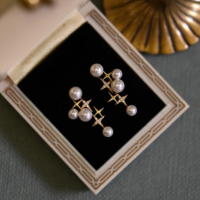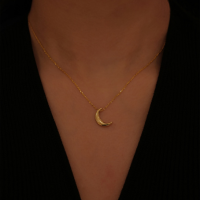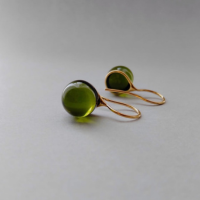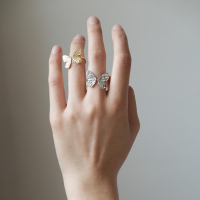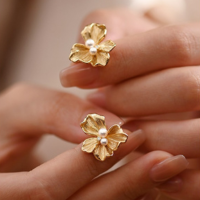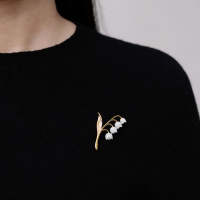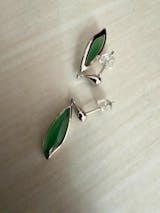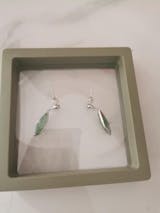
How to Identify Antique Brooches: A Beginner’s Guide
Check out our personalized jewelry collections! (kids drawing jewelry, coin jewelry, wire jewelry, fingerprint jewelry, handwriting jewelry, and more)
Antique brooches are more than just beautiful accessories; they hold stories from the past. Recognizing an antique brooch involves looking at its materials, design, and the craftsmanship that went into making it. With so many unique pieces out there, it’s exciting to learn how to identify these treasures and appreciate their history.
Understanding the styles and eras of brooches helps us appreciate their uniqueness. From Victorian to Art Deco, each period has its own look and feel. Recognizing these styles can guide us in dating and valuing a piece.
Collecting antique brooches can be a rewarding hobby. With the right knowledge, we can find genuine pieces that enhance our collection and reflect historical artistry.
Key Takeaways
- Knowing brooch styles aids in identifying them.
- Material and craftsmanship reveal the brooch's age.
- Proper care ensures their lasting beauty.
The History and Evolution of Brooches
Brooches have a long and fascinating history. They first appeared in ancient times as practical items used to fasten clothing. Our ancestors crafted them from simple materials like bone, wood, and metal. They were essential before buttons and zippers took over.
During the Middle Ages, brooches became more decorative. We can see that they were often made with intricate designs and used precious metals. Noble families wore them as a sign of wealth and status. Brooches were often gifted as tokens of loyalty and love.
In the Victorian era, brooches reached new heights of style. We saw them adorned with gems and intricate motifs. This was also the time of mourning brooches, which held locks of hair from loved ones who had passed away.
20th Century and Beyond:
- Art Nouveau (1890-1910): Nature-inspired designs became popular.
- Art Deco (1920-1930): Bold geometric shapes and bright colors took center stage.
- Mid-Century Modern (1950s-1960s): Sleek and minimalist styles emerged.
Today, brooches continue to evolve. We see a blend of classic and modern styles, allowing us to express personal taste. They are no longer just a fashion statement—they tell a story of art, culture, and history.
Materials and Craftsmanship
When looking at antique brooches, it's important to look at both the materials used and the quality of craftsmanship. By knowing what to search for in metals, gemstones, and other materials, we can tell more about a piece’s history and value.
Precious Metals
Antique brooches often use metals like gold, silver, and platinum. Gold is usually marked with karats like 18k or 22k, showing its purity. Sterling silver, with a mark of 925, is also common. Platinum, being rare, adds value and was often used in elegant designs from the early 20th century. We should inspect these marks under a magnifying glass to confirm authenticity, ensuring they match the era the brooch is from.
Sometimes, we might find alloys like pinchbeck, used as a gold substitute in the 19th century. These are less valuable but still interesting. Knowing these details helps us appreciate the unique history of each piece.
Gemstones and Enamel
Gemstones in antique brooches might include diamonds, rubies, sapphires, and emeralds. These stones can be identified by their cut and setting. Old cuts, like the rose or mine cut, can suggest older, more valuable pieces. Enamel work is another sign of craftsmanship, seen in vibrant colors on brooches from the Art Nouveau and Art Deco periods.
To check for authenticity, we should look for signs of wear or repair on stones and enamel. Original and well-preserved gems and enamel tend to add more to the value. Recognizing these qualities helps us decide if a brooch is worth collecting.
Glass and Other Materials
Not all brooches have precious gems. Some feature beautiful glass stones, cameos, or pearls. Paste glass, especially popular in the Victorian era, was artfully crafted to mimic diamonds. Cameos might be carved from shell or coral. We should check for age-related factors, like a patina on these materials, showing genuine age.
Other less common materials can surprise us, like jet, used in mourning jewelry, or bakelite, popular in the early 20th century. Knowing these materials helps us evaluate both historical and sentimental value. Each type gives the brooch a distinct charm and style unique to its time.
Styles and Eras
Antique brooches come in many styles, with each era showing unique characteristics and designs. By recognizing these styles, we can identify and appreciate the history behind each piece. Let's explore the distinct styles of the Georgian, Victorian, Art Nouveau, Art Deco, and Retro eras.
Georgian
The Georgian era, spanning from 1714 to 1837, showcases brooches that are both elegant and opulent. During this time, jewelry often featured detailed hand-crafted designs. Common motifs included natural themes such as leaves and flowers. Gemstones like diamonds and pearls were favorites, often set in silver.
Engravings and open-backed settings were typical, allowing light to enhance the gemstones' brilliance. Intricacy was a hallmark, with pieces often reflecting the skilled craftsmanship of the time.
Victorian
Victorian brooches hold a special place in the history of jewelry. The era, from 1837 to 1901, is marked by a wide variety in styles due to Queen Victoria's influence. Early Victorian jewelry often featured romantic themes, such as hearts or bows. We often see vibrant, colorful gemstones during this time.
Mourning jewelry became significant after Prince Albert's death, with brooches in somber black materials like jet. By the late Victorian period, aesthetics became more elaborate, with intricate filigree work and the use of innovative materials.
Art Nouveau
From the late 19th century to around 1910, Art Nouveau brooches became popular for their emphasis on nature and the female form. Soft, flowing lines and organic shapes defined this style. Enamel work became a popular technique, adding colored details to the designs.
Artists often incorporated elements like flowers, insects, and the mystical femme fatale figure. The colors and materials were varied, with gemstones such as opals and moonstones used frequently to create an ethereal effect.
Art Deco
Art Deco brooches, emerging in the 1920s to 1930s, are unmistakable for their geometric shapes and bold lines. The style reflects the modernism of the era, with sharp edges and contrasts in color. Think of streamlined forms and symmetry.
This period featured new materials such as bakelite and modern metal alloys. Gemstones like emeralds and sapphires, set in clean lines, highlighted the artful designs. Art Deco brooches often embodied the luxurious and glamorous spirit of the Roaring Twenties.
Retro and Modernist
Retro and Modernist styles, from the 1940s to 1960s, adapted to a rapidly changing world. Retro brooches were often large and bold, reflecting Hollywood glamor. We saw heavy use of yellow and rose gold. Themes in designs often included bows and knots, suggesting optimism post-war.
Moving into the Modernist period, brooches embraced abstract designs with unusual materials such as plastics or ceramics. Artists focused on form and functionality, with brooches often showing minimalistic and avant-garde attributes. This time marked an exploration of new artistic expressions and techniques.
Identification and Dating Techniques
We will explore practical ways to identify and date antique brooches, focusing on hallmarks, construction, and design features. These elements help determine a brooch's age and origin.
Hallmarks and Maker's Marks
Hallmarks and maker's marks are essential for identifying antique brooches. These marks are usually stamped on the metal and provide information about the maker, metal content, and sometimes the date and place of manufacture.
Common Hallmarks
- Metal Purity Marks: Indicate the metal type, like gold or silver.
- Date Letters: Seen in some countries like the UK, where a letter represents a specific year.
- Maker's Marks: Symbols or initials that identify the creator.
Examining these marks with a magnifying glass or jeweler's loupe can reveal valuable insights. We should consult reference books or online databases for more details on specific marks.
Construction Methods
Construction techniques offer clues about when and where a brooch was made. Older brooches may feature hand-crafted pin mechanisms and clasps that modern techniques do not use.
Key Construction Features
- C-clasps: Common in Victorian brooches.
- Trombone Clasps: Often found in vintage European jewelry.
- Materials and Technique: Hand-cut stones and intricate metalwork may imply an earlier period.
Recognizing these features helps us place a brooch within a specific time frame. Observation of solder points and wear patterns can also provide hints about the brooch's history.
Design Analysis
The design of an antique brooch often reflects the era in which it was created. Art movements and historical events influence these designs, offering hints about the brooch's age.
Popular Design Eras
- Victorian: Known for floral and symbolic designs.
- Art Nouveau: Features flowing lines and nature motifs.
- Art Deco: Characterized by geometric shapes and bold colors.
Understanding the design allows us to narrow down its origin. It's useful to compare with imagery from catalogues or museums to match styles more accurately.
Condition and Authenticity
When evaluating antique brooches, condition and authenticity are crucial. We look at wear and patina, check for repairs, and ensure authenticity through specific signs. Knowing these elements helps us understand each piece's history and value.
Wear and Patina
Wear can tell us a lot about a brooch's age and use. Over time, the surface of a brooch may develop a patina, which is a kind of natural tarnish. This can add character and even enhance the piece's appeal.
Patina can highlight intricate designs and show that the brooch is genuinely old. Heavy wear, like scratches and dents, might reduce value. It’s essential to check for balanced wear across the piece to ensure it’s aged naturally.
We should inspect areas like the clasp and pin. These parts often show the most wear. Patina should be appreciated, not removed, to keep the brooch's authenticity intact.
Repairs and Restorations
Many antique brooches have had repairs over the years. Knowing how to spot these changes is vital. Look for newer soldering marks, which may indicate repairs. Matching metal is key; repairs with different metals can affect the brooch's look and value.
In some cases, restorations may enhance a piece, maintaining the original design. However, we should be aware that too many alterations might diminish value. Check the gemstone settings for any signs of being replaced or repaired.
Tracking any restorations or repairs can help in future appraisals. While repairs can maintain a brooch's usability, they need to be in line with the original craftsmanship.
Signs of Authenticity
Authenticity signs include hallmarks, maker's marks, and materials used. Hallmarks can indicate where or when a piece was made. Original maker's marks show us who crafted the brooch, often adding to its value.
Materials like real gold, silver, and precious stones suggest authenticity. Pay attention to the craftsmanship; high-quality work is a good sign. We should be cautious of reproductions that mimic past designs without genuine age or craftsmanship.
Authentic brooches tell their own story through these signs, offering both history and value. Familiarizing ourselves with these markers enhances our understanding and appreciation of each piece.
Valuation and Appraisal
When it comes to antique brooches, knowing their value is important. We can start by examining materials like gold, silver, or gemstones. Precious materials often mean a higher value.
Next, let's look at craftsmanship. High-quality designs and maker's marks can raise the price. We should check for any signatures or logos on the brooch.
Age and history are also key factors. Older pieces, especially those with a known story, can be worth more. We need to research the era or designer if possible.
Condition matters too. Brooches in mint condition are more valuable. Damage or repairs might lower the value. We should always examine the piece closely.
For professional appraisal, it is best to consult a certified jeweler or antique expert. They have the skills to give us an accurate estimate.
Let's also consider market trends. Sometimes, certain styles become more popular, which can affect prices. Keeping an eye on auctions can help us understand current values.
Using these tips, we can better estimate the worth of our antique brooches. Staying informed and asking for expert opinions will guide us in our journey.
Care and Preservation
Antique brooches are treasures that require careful handling. Regular cleaning is essential to keep them sparkling. We should use a soft, damp cloth for gentle cleaning. Avoid chemicals as they can damage delicate materials.
Storing our brooches properly is also crucial. We recommend keeping them in a soft fabric pouch or a separate compartment in a jewelry box. This prevents scratches and environmental damage.
Temperature and humidity control help preserve our brooches. High humidity can corrode metals, and extreme temperatures alter the brooch's materials. Keeping them in a stable environment is key.
Regular inspections help us spot any potential wear and tear early. Look for loose stones, worn prongs, or bent pins. Addressing these issues promptly ensures they remain in excellent condition.
When wearing antique brooches, attach them to thicker fabrics. This reduces the risk of bending or breaking the pin. Removing the brooch before activities like exercising or swimming further protects it.
Where to Find and Purchase Antique Brooches
As lovers of antique jewelry, we're often on the lookout for unique brooches. Whether attending auctions, browsing antique shops, or shopping online, each avenue offers its charm and specific details worth knowing.
Auctions and Estate Sales
Auctions and estate sales are thrilling places to discover rare antique brooches. Here, we often find exclusive pieces with historical significance. Attending these events requires a keen eye and quick decision-making, as others are likely hunting for treasures as well.
We recommend researching upcoming auctions to see if they specialize in jewelry or particular time periods. Estate sales might be especially promising when held by families with rich histories or collections. Always arrive early to examine items closely and set a budget for bidding.
Antique Shops and Jewelry Dealers
Antique shops and jewelry dealers offer a more relaxed experience. We can take our time to assess each brooch’s condition and origin. These dealers often have a connection to trusted appraisers, which can assure us of a piece's authenticity.
Building a relationship with local dealers can be beneficial. They might give us a heads-up about new finds or even keep an eye out for specific types of brooches we're interested in. It’s a friendly space for conversations about jewelry and history, enhancing our buying experience.
Online Marketplaces
Online marketplaces open up a world of possibilities for our search. Websites like eBay, Etsy, and specialized antique platforms give us access to brooches from different eras without leaving our home. Here, it's crucial to read descriptions thoroughly and examine photos closely.
Before purchasing, we make sure to check the seller’s reviews and ratings. Communicating with sellers can provide additional information or assurance about an item’s provenance. Digital marketplaces often feature a range of prices, making it easier to find something within our budget while still capturing a unique piece.
Frequently Asked Questions
When identifying antique brooches, we focus on features like design, materials, hallmarks, and clasps. These details can reveal a lot about a brooch's age and origin.
What distinguishes a vintage brooch from a modern one?
Vintage brooches often have intricate designs and are made from materials that might not be used today. They can show signs of wear, adding character. Modern pieces usually reflect current trends and are made with newer manufacturing techniques.
What can the hallmark on a brooch tell us about its age and origin?
Hallmarks provide clues about the maker, the metal quality, and the period it was produced. Certain symbols or letter stamps can tell us where and when a piece was made. Examining them carefully can offer valuable insights into authenticity and history.
Which types of clasps can indicate a brooch's period of manufacture?
The type of clasp used can help date a brooch. Early designs often feature 'C' clasps, while later pieces might use safety clasps. Different periods favored different clasp styles, allowing us to estimate the brooch's age.
How do I evaluate the worth of an antique brooch?
To assess value, consider the materials, rarity, condition, and historical importance. A brooch with precious stones or a notable maker's mark can be more valuable. Consulting with a professional appraiser can provide a more accurate valuation.
Can the style and materials of a brooch provide clues to its authenticity?
Yes, the style and materials are key identifiers. Authentic brooches often use period-specific materials such as glass, pearls, or gold. The design should align with fashion trends from the era it was made. Checking these can help confirm authenticity.
What are some tips for dating brooches from the 1950s?
1950s brooches often feature bold and colorful designs. Look for mid-century motifs like flowers or abstract shapes. Material like rhinestones or lucite was popular. Examining these aspects can help determine if a brooch is from this vibrant decade.

